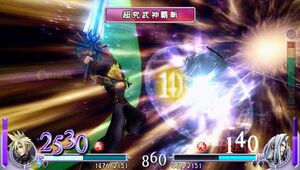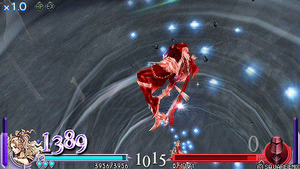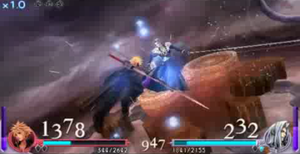Gameplay[edit]
A video example showing how a fight works within Dissidia
Dissidia is an action-based fighting game mixed with RPG elements. Battles take place on fully rendered 3D fields, where the scenery might be damaged because of the fight. Destroying pillars and other objects builds up the character's "Brave" meter.
Brave points represent the attack power of the character's attacks. They can be obtained by directly attacking the opponent's Brave Points, which will result in the decrease of the opponent's Brave and in the increase of the player's points, in equal proportions and depending on the attacker's attack stat and the target's defense stat; and can also be changed by summons.
Whenever a character loses all of its Brave points, they will enter Break Mode, being left defenseless, and the opponent's brave count will increase according to the quantity shown between the characters' health bars. Whenever a character deals a successful HP attack, his Brave Points will be reduced to zero, making him vulnerable to a counter attack.
There is also an "EX Bar" meter which fills up during battle from attacking or from acquiring the EX Cores placed around the stages. Once filled, the character can enter EX Mode which grants a character-specific bonus and gives access to an EX Burst, a special move that deals massive damage to their opponent. These moves are often a reference to each character's respective game, such as Squall using his Renzokuken or Kefka Palazzo using Light of Judgment. After the battle is over, characters are rewarded with Gil, EXP, and AP. Characters level up in the game, the max being level 100. Depending on the player skills and equipment, any level character can defeat any other theoretically.

The battles in Dissidia are divided into stages, each taking place on its own checkerboard-like map. Characters will be moved around the board, able to pick up equipment and potions on the map and fight whenever they stop adjacent to an enemy. "Destiny Points", also known as DP, are needed to move around the board. Characters can collect more DP by fighting non-boss enemies on the board. These non-boss enemies are pallete-swaps of other characters of the game. The energy of characters is not refilled after battles with regular enemies, so grabbing items and equipment on the board is the key to winning a battle and being prepared for the next. Each character must progress through their own series of stages to complete their storyline. Once all ten storylines are complete, the player can access the eleventh stage which serves as the final area leading to the final boss of the game.
EX Mode[edit]
EX Mode effectively serves as the game's Limit Break system, granting the user an extreme boost in power. This grants access to new abilities, including the highly powerful EX Burst.
A video showing all character's Ex Bursts
To enter EX Mode, players must fill up their EX Bar located next to their health meter by attacking and being attacked. When a player is hit with an attack, EX Force will appear and collecting EX Force fills up the EX Bar. Once the EX Bar is full, the player can enter EX Mode by pressing the ![]() and
and ![]() buttons at once. In the short time that a character enters EX Mode, he is invincible, and can interrupt even HP attacks. Once EX Mode is entered, the EX Bar drains, and EX Mode ends when it empties. The EX Bar can also be filled by collecting items called EX Cores, which appear around the arena. Other factors may also affect when and how the EX Bar fills as well - in a trailer depicting a fight between Cloud and Sephiroth, at one point both their EX Bars fill slowly without them trading blows.
buttons at once. In the short time that a character enters EX Mode, he is invincible, and can interrupt even HP attacks. Once EX Mode is entered, the EX Bar drains, and EX Mode ends when it empties. The EX Bar can also be filled by collecting items called EX Cores, which appear around the arena. Other factors may also affect when and how the EX Bar fills as well - in a trailer depicting a fight between Cloud and Sephiroth, at one point both their EX Bars fill slowly without them trading blows.
While in EX Mode, players are under Regen status and will slowly regenerate health. Their appearance also changes,they get a higher chance to get critical hits, they gain new abilities and their attack power increases, giving them stronger attacks they would normally not have access to. For example, several characters gain the ability to glide, while others have the range of their attacks increase. In this, EX Mode can easily turn the tiding of a losing battle.
For most of Dissidia's playable cast, their EX Modes involve a transformation of theirs from their original game. For example, Sephiroth enters his "one-winged angel" form, Ultimecia fuses with Griever, Warrior of Light class-changes, Zidane enters Trance, and so forth. The fighters who do not transform — Firion, Cloud, Squall, and Tidus, instead have their weapons transform into their ultimate weapons, such as Squall's Revolver into the Lion Heart or Firion's weapons into "blood" weapons.
EX Burst[edit]

During EX Mode, the player can execute an EX Burst, an extremely powerful attack that can inflict a great deal of damage to opponents. After connecting with an HP attack while in EX Mode, an icon appears on the screen. If ![]() is pressed again while the icon is visible the character will use their EX Burst. Once an EX Burst is triggered, there is a sequence in which the player charges up the EX Burst (the exact method varies for each fighter), followed by the attack executing. EX Bursts tend to be devastating, capable (but not guaranteed) of depleting all of an opponent's HP. Once the EX Burst is executed, EX Mode is automatically canceled.
is pressed again while the icon is visible the character will use their EX Burst. Once an EX Burst is triggered, there is a sequence in which the player charges up the EX Burst (the exact method varies for each fighter), followed by the attack executing. EX Bursts tend to be devastating, capable (but not guaranteed) of depleting all of an opponent's HP. Once the EX Burst is executed, EX Mode is automatically canceled.
For the games in which the Limit Break system exists, EX Bursts are based on that character's Limit Break. For example, Terra uses Riot Blade, Cloud uses Omnislash, Squall uses Renzokuken, and so forth. For the characters from games that do not have a Limit Break system, their EX Burst is more original. Cecil's EX Burst involves magic and sword slashes, Bartz's revolves around his abilities as a Mime, etc. For the villains, some of their EX Bursts are either based on their strongest attacks, like Kefka's "Light of Judgment"/"Forsaken", or Cloud of Darkness's "Super Wave Cannon", based on her "Particle Beam" move; or, in majority, entirely original, like Garland's "Soul of Chaos".
Board Enemies[edit]

Board Enemies are the main enemy types in Dissidia Final Fantasy. They appear as colored palette swaps of the twenty-two playable characters, with crystal-like texture and colored a single color reflective of that character's original game. Their battle cries are also garbled, distorted versions of their counterpart's.
Board Enemies function identically to their palette swaps; they have the same attacks, the ability to inflict HP damage, as well as enter EX Mode. However, Board Enemies tend to be much weaker than normal characters, with lower HP and an easier AI script. They also cannot perform EX Bursts, and though they can enter EX Mode they do not alter their appearance when doing so. Their icon is not that of their character, but another icon.
Enemy Types[edit]

There are various kinds of board enemies that can be encountered when playing through each character's story modes. There is a basic enemy, which is represented on the board by a single gray icon. This enemy is very low leveled and is considered to be an easy enemy to defeat. There is also a medium difficulty enemy, which is represented by a gray icon with swords on the back of it. This enemy is higher leveled with a small increase in difficulty. The last type of board enemy that can be encountered is represented by a single gold icon. This enemy will have very low HP but will have an abnormally high level of Brave points at the start of the battle. The difficulty of these enemies is higher than a basic enemy. On some occasions all three of these enemies will award you a +1 to your Destiny Point total if you meet a requirement listed on their board description.

Aside from the previously mentioned enemies there are also boss versions of the board enemies. There is both a medium and hard level of these enemies. The medium level enemies are represented by large brown icons with dull gold markings and shoulders. These enemies are higher leveled than the other basic enemies and are at a higher difficulty level. The hard level of boss enemies can only be encountered during a second playthough of a character's story. They are also represented by a large gray icon with dull gold markings and shoulders, however, there are six spikes coming off the icon's shoulders which differs from the medium level icon. These enemies are both higher in level and difficulty than any of the previously mentioned enemies. Both of these enemies will always give you a chance to earn Destiny Points. The medium level enemy will give you a chance to earn +1 to your total, while the harder version will give you a chance to earn +2.
Chase Sequences[edit]

Chase Sequences are a gameplay term in Dissidia Final Fantasy. Some attacks cause the enemy to be thrown away if executed correctly, and allow the start of a Chase Sequence by showing the ![]() button. Pressing the
button. Pressing the ![]() button causes the player character to leap into the air, following their opponent in mid-air, initiating the Chase Sequence.
button causes the player character to leap into the air, following their opponent in mid-air, initiating the Chase Sequence.
In Chase Sequences, the two players are suspended in the air. The player who initiated the sequence is given a chance to perform one of two attacks on the opponent - a Brave Attack, or an HP Attack. There is a slight lag between pressing the button for an attack and the attack executing, and the lag is longer for HP Attacks. If the opponent presses the ![]() button at the right time, they can dodge the attack and are then given a chance to execute an attack of their own. Dodges can also be directed horizontally by moving the analog stick to the left or right. Every attack, regardless of if it hits or misses, causes EX Force to appear in a larger quantity.
button at the right time, they can dodge the attack and are then given a chance to execute an attack of their own. Dodges can also be directed horizontally by moving the analog stick to the left or right. Every attack, regardless of if it hits or misses, causes EX Force to appear in a larger quantity.

In terms of gameplay, Chase Sequences prevent players from actively moving or dodging to avoid being struck, and the player must instead time their button presses correctly to avoid damage. If either player lands a Brave Attack, the opponent is knocked back and the player is given a chance to pursue them and attack again. If they miss, the Chase Sequence continues as told above. You can change the direction of which your foe is sent flying by moving the analog stick up, down or stationary. Chase Sequences automatically cancel after three rounds if neither player lands a hit. They also cancel when either player lands an HP Attack, or when they are knocked back and strike an obstacle of some kind, including the arena edge or ceiling.
Chase Sequences are more notable for Gabranth than most other characters. As Gabranth has no HP Attacks outside of EX Mode, initiating a Chase Sequence is the only way he can inflict HP damage outside of EX Mode. Also, the "Auto-Chase" ability allows the character to automatically initiate a Chase Sequence when the opportunity arises when equipped.